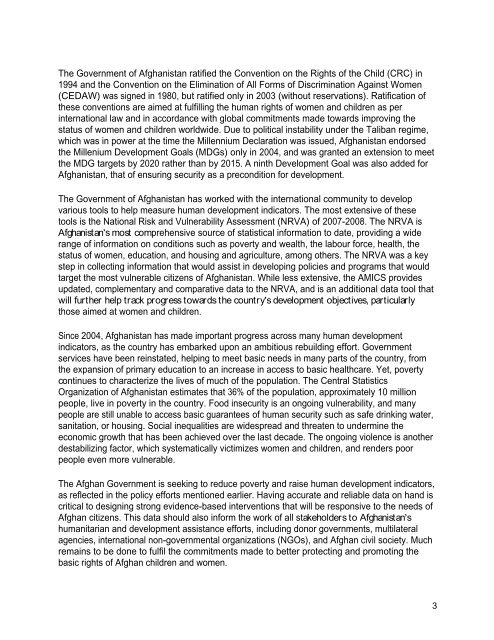Microsoft Word - AMICS-29Jan2013 - Childinfo.org
Microsoft Word - AMICS-29Jan2013 - Childinfo.org
Microsoft Word - AMICS-29Jan2013 - Childinfo.org
You also want an ePaper? Increase the reach of your titles
YUMPU automatically turns print PDFs into web optimized ePapers that Google loves.
The Government of Afghanistan ratified the Convention on the Rights of the Child (CRC) in<br />
1994 and the Convention on the Elimination of All Forms of Discrimination Against Women<br />
(CEDAW) was signed in 1980, but ratified only in 2003 (without reservations). Ratification of<br />
these conventions are aimed at fulfilling the human rights of women and children as per<br />
international law and in accordance with global commitments made towards improving the<br />
status of women and children worldwide. Due to political instability under the Taliban regime,<br />
which was in power at the time the Millennium Declaration was issued, Afghanistan endorsed<br />
the Millenium Development Goals (MDGs) only in 2004, and was granted an extension to meet<br />
the MDG targets by 2020 rather than by 2015. A ninth Development Goal was also added for<br />
Afghanistan, that of ensuring security as a precondition for development.<br />
The Government of Afghanistan has worked with the international community to develop<br />
various tools to help measure human development indicators. The most extensive of these<br />
tools is the National Risk and Vulnerability Assessment (NRVA) of 2007-2008. The NRVA is<br />
Afghanistan s most comprehensive source of statistical information to date, providing a wide<br />
range of information on conditions such as poverty and wealth, the labour force, health, the<br />
status of women, education, and housing and agriculture, among others. The NRVA was a key<br />
step in collecting information that would assist in developing policies and programs that would<br />
target the most vulnerable citizens of Afghanistan. While less extensive, the <strong>AMICS</strong> provides<br />
updated, complementary and comparative data to the NRVA, and is an additional data tool that<br />
will further help track progress towards the country s development objectives, particularly<br />
those aimed at women and children.<br />
Since 2004, Afghanistan has made important progress across many human development<br />
indicators, as the country has embarked upon an ambitious rebuilding effort. Government<br />
services have been reinstated, helping to meet basic needs in many parts of the country, from<br />
the expansion of primary education to an increase in access to basic healthcare. Yet, poverty<br />
continues to characterize the lives of much of the population. The Central Statistics<br />
Organization of Afghanistan estimates that 36% of the population, approximately 10 million<br />
people, live in poverty in the country. Food insecurity is an ongoing vulnerability, and many<br />
people are still unable to access basic guarantees of human security such as safe drinking water,<br />
sanitation, or housing. Social inequalities are widespread and threaten to undermine the<br />
economic growth that has been achieved over the last decade. The ongoing violence is another<br />
destabilizing factor, which systematically victimizes women and children, and renders poor<br />
people even more vulnerable.<br />
The Afghan Government is seeking to reduce poverty and raise human development indicators,<br />
as reflected in the policy efforts mentioned earlier. Having accurate and reliable data on hand is<br />
critical to designing strong evidence-based interventions that will be responsive to the needs of<br />
Afghan citizens. This data should also inform the work of all stakeholders to Afghanistan s<br />
humanitarian and development assistance efforts, including donor governments, multilateral<br />
agencies, international non-governmental <strong>org</strong>anizations (NGOs), and Afghan civil society. Much<br />
remains to be done to fulfil the commitments made to better protecting and promoting the<br />
basic rights of Afghan children and women.<br />
3

















